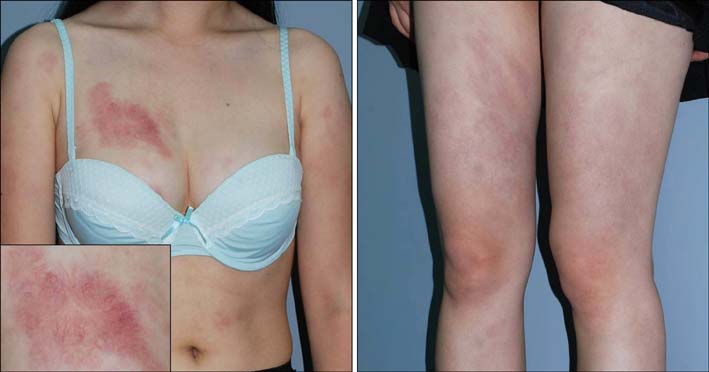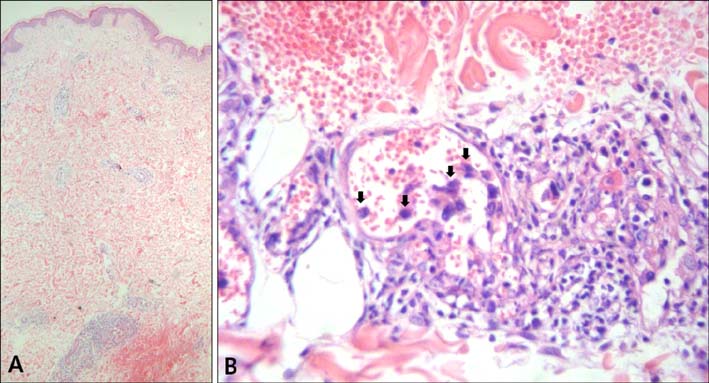Ann Dermatol.
2014 Aug;26(4):496-500. 10.5021/ad.2014.26.4.496.
Intravascular Cytotoxic T-Cell Lymphoma in a Young Immunocompetent Woman
- Affiliations
-
- 1Department of Dermatology, Kyungpook National University School of Medicine, Daegu, Korea. seokjong@knu.ac.kr
- 2Department of Pathology, Kyungpook National University School of Medicine, Daegu, Korea.
- 3Department of Oncology/Hematology, Kyungpook National University School of Medicine, Daegu, Korea.
- KMID: 2265592
- DOI: http://doi.org/10.5021/ad.2014.26.4.496
Abstract
- Intravascular lymphoma (IVL) is a rare disorder characterized by the presence of large neoplastic lymphoid cells restricted to the lumens of small vessels with a predilection for the skin and the central nervous system. While the vast majority of cases involving IVL are of B-cell lineage, the disease rarely affects the T-cell, the histiocytes, and the natural killer cells. We report a case of intravascular T-cell lymphoma (IVTL) associated with Epstein-Barr virus (EBV). A 23-year-old healthy woman presented with tender indurated erythematous patches with overlying telangiectasia on her right breast, abdomen, both the upper and the lower extremities and the back for 3 months. The pathology revealed an infiltration of dermal and subcutaneous vessels by large and atypical lymphoid cells with immunohistochemical features of the T-cell lineage with a cytotoxic phenotype (CD3+, CD8+, granzyme B+, TIA-1+, CD4-, CD5-, CD20-, CD56-). Interestingly, the DNA extracted from the skin biopsies demonstrated evidence of a monoclonal immunoglobulin heavy chain gene rearrangement, but no T-cell receptor gene rearrangement was found. In situ hybridization study for EBV-encoded RNA was positive. She was diagnosed with an EBV-associated IVTL. The patient's skin lesions were refractory to the combination of chemotherapy and autologous stem cell transplant, and she expired. The findings in the present case may highlight the unique clinicopathologic aspects of EBV-associated cytotoxic IVTL that occurred in a young, immunocompetent woman.
Keyword
MeSH Terms
-
Abdomen
B-Lymphocytes
Biopsy
Breast
Central Nervous System
DNA
Drug Therapy
Female
Gene Rearrangement
Genes, T-Cell Receptor
Granzymes
Herpesvirus 4, Human
Histiocytes
Humans
Immunoglobulin Heavy Chains
In Situ Hybridization
Killer Cells, Natural
Lower Extremity
Lymphocytes
Lymphoma
Lymphoma, T-Cell*
Pathology
Phenotype
RNA
Skin
Stem Cells
T-Lymphocytes
Telangiectasis
Young Adult
DNA
Granzymes
Immunoglobulin Heavy Chains
RNA
Figure
Cited by 1 articles
-
Intravascular NK/T-cell lymphoma: a case report and literature review
Ji Min Na, Wookjae Jung, Minhye Kim, Yun-Hong Cheon, Jong Sil Lee, Dae Hyun Song, Jung Wook Yang
J Pathol Transl Med. 2023;57(6):332-336. doi: 10.4132/jptm.2023.10.30.
Reference
-
1. Pfleger L, Tappeiner J. On the recognition of systematized endotheliomatosis of the cutaneous blood vessels (reticuloendotheliosis?). Hautarzt. 1959; 10:359–363.2. Cerroni L, Massone C, Kutzner H, Mentzel T, Umbert P, Kerl H. Intravascular large T-cell or NK-cell lymphoma: a rare variant of intravascular large cell lymphoma with frequent cytotoxic phenotype and association with Epstein-Barr virus infection. Am J Surg Pathol. 2008; 32:891–898.3. Rieger KE, Polidore T, Warnke R, Kim J. ALK-negative systemic intravascular anaplastic large cell lymphoma presenting in the skin. J Cutan Pathol. 2011; 38:216–220.
Article4. Ferreri AJ, Campo E, Seymour JF, Willemze R, Ilariucci F, Ambrosetti A, International Extranodal Lymphoma Study Group (IELSG), et al. Intravascular lymphoma: clinical presentation, natural history, management and prognostic factors in a series of 38 cases, with special emphasis on the 'cutaneous variant'. Br J Haematol. 2004; 127:173–183.
Article5. Wang L, Li C, Gao T. Cutaneous intravascular anaplastic large cell lymphoma. J Cutan Pathol. 2011; 38:221–226.
Article6. Gleason BC, Brinster NK, Granter SR, Pinkus GS, Lindeman NI, Miller DM. Intravascular cytotoxic T-cell lymphoma: a case report and review of the literature. J Am Acad Dermatol. 2008; 58:290–294.
Article7. Wu H, Said JW, Ames ED, Chen C, McWhorter V, Chen P, et al. First reported cases of intravascular large cell lymphoma of the NK cell type: clinical, histologic, immunophenotypic, and molecular features. Am J Clin Pathol. 2005; 123:603–611.
Article8. Takahashi E, Kajimoto K, Fukatsu T, Yoshida M, Eimoto T, Nakamura S. Intravascular large T-cell lymphoma: a case report of CD30-positive and ALK-negative anaplastic type with cytotoxic molecule expression. Virchows Arch. 2005; 447:1000–1006.
Article9. Suh CH, Kim SK, Shin DH, Chung KY, Kim SK. Intravascular lymphomatosis of the T cell type presenting as interstitial lung disease--a case report. J Korean Med Sci. 1997; 12:457–460.
Article10. Au WY, Shek WH, Nicholls J, Tse KM, Todd D, Kwong YL. T-cell intravascular lymphomatosis (angiotropic large cell lymphoma): association with Epstein-Barr viral infection. Histopathology. 1997; 31:563–567.
Article11. Williams G, Foyle A, White D, Greer W, Burrell S, Couban S. Intravascular T-cell lymphoma with bowel involvement: case report and literature review. Am J Hematol. 2005; 78:207–211.
Article12. Cerroni L, Gatter K, Helmut K. Skin lymphoma: the illustrated guide. 3th ed. Philadelphia: WB Sauders;2009. p. 178–179.13. Cossman J, Zehnbauer B, Garrett CT, Smith LJ, Williams M, Jaffe ES, et al. Gene rearrangements in the diagnosis of lymphoma/leukemia. Guidelines for use based on a multiinstitutional study. Am J Clin Pathol. 1991; 95:347–354.
Article14. Thériault C, Galoin S, Valmary S, Selves J, Lamant L, Roda D, et al. PCR analysis of immunoglobulin heavy chain (IgH) and TcR-gamma chain gene rearrangements in the diagnosis of lymphoproliferative disorders: results of a study of 525 cases. Mod Pathol. 2000; 13:1269–1279.
Article15. Jalkanen S, Aho R, Kallajoki M, Ekfors T, Nortamo P, Gahmberg C, et al. Lymphocyte homing receptors and adhesion molecules in intravascular malignant lymphomatosis. Int J Cancer. 1989; 44:777–782.
Article16. Chen G, Shankar P, Lange C, Valdez H, Skolnik PR, Wu L, et al. CD8 T cells specific for human immunodeficiency virus, Epstein-Barr virus, and cytomegalovirus lack molecules for homing to lymphoid sites of infection. Blood. 2001; 98:156–164.
Article




